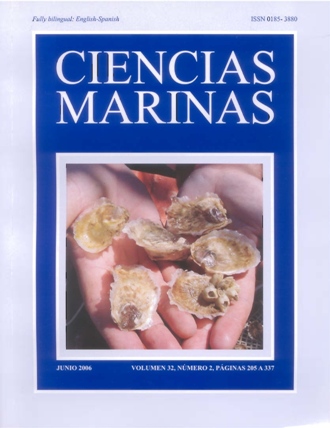Geochemistry of Fe, Ti and Al as an indicator of volcanoclastic sedimentation in San Quintín coastal lagoon, Baja California, Mexico
Main Article Content
Abstract
The geochemistry of Fe, Ti and Al and the grain-size distribution were studied in 32 surficial sediment samples from San Quintín coastal lagoon (SQCL) in Baja California, in order to identify the presence of volcanoclastic sediment derived from the weathering and erosion of basaltic rocks from the San Quintín volcanic field (SQVF). The composition of the SQVF rocks is characterized by high Fe and Ti concentrations in comparison with the continental crust and Peninsular Ranges batholith. Similarly, the sediments from SQCL have significantly higher Fe concentrations (mean 3.73%, standard deviation [S] ±0.99) than other coastal sediments from Baja California and other regions. The high Fe concentrations normalized relative to the percentage of the <63-µm sediment fraction (Fenorm), indicate that the enrichment of Fe in some samples may in part be due to the presence of heavy minerals and/or rock particles, which were derived from the weathering and erosion of SQVF. The high concentrations of Ti (mean, 0.54%, S ±0.19) in the sediment are atypical for coastal and marine sediments. This enrichment as well as the high Ti/Al ratios at some sites within SQCL, especially Falsa Bay (FB), support the hypothesis of a volcanogenic influence. The sediment samples that have the highest proportion of amorphous Fe oxyhydroxides (≥50% of bulk Fe) were found in FB. This fact and the high Fenorm and Ti concentrations, as well as high Ti/Al ratios, suggest an association (at least in part) between the amorphous Fe oxyhydroxides and the volcanoclastic particles in some samples from FB; however, the high variability in geochemical characteristics of the sediment suggests a complex combination of hydrodinamic, mineralogical and diagenetic properties in SQCL.
Downloads
Article Details
This is an open access article distributed under a Creative Commons Attribution 4.0 License, which allows you to share and adapt the work, as long as you give appropriate credit to the original author(s) and the source, provide a link to the Creative Commons license, and indicate if changes were made. Figures, tables and other elements in the article are included in the article’s CC BY 4.0 license, unless otherwise indicated. The journal title is protected by copyrights and not subject to this license. Full license deed can be viewed here.

